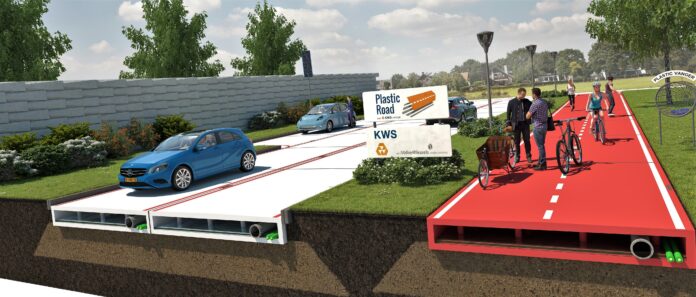A Stagnant Century of Asphalt
For the past century, road and bridge construction has remained largely unchanged with traditional asphalt being the go-to material. The asphalt mixture, consisting of sand and crushed rock combined with bitumen, a semi-solid petroleum product, has dominated the construction industry. However, the emergence of innovative ideas using recycled plastic as potential alternatives is disrupting the status quo.
The Emergence of Plastic Roads
Innovative road construction is on the horizon with the emergence of PlasticRoads, modular road sections entirely made of recycled plastic. The concept, developed by KWS Infra, a division of VolkerWessels, involves producing sections in a factory and assembling them on-site. These lightweight sections, made of 100% recycled material, would be lighter than traditional asphalt, leading to a roadbed that is less susceptible to subsidence.
According to VolkerWessels, the PlasticRoad technology can be installed more quickly and last longer than asphalt while requiring less maintenance. The lightweight road sections also have a hollow core that can be used for utilities such as electrical and telecommunication cables, sewer and water pipes, and drainage.
Revolutionizing Bridge Construction with Recycled Plastic
In addition to revolutionizing road construction, recycled plastic is also transforming bridge construction. The technology for thermoplastic composite bridges was developed in the late 1980s, and the composite polymer used to make the bridge components is 80 percent post-consumer high-density polyethylene and 20 percent recycled polystyrene plastics. AXION International manufactures the bridge materials in conjunction with Rutgers University.
Currently, only two bridges in the United States are made of 100 percent recycled plastics, both funded by the Innovative Bridge Research and Deployment Program. The longest recycled plastic bridge, located in Peeblesshire, Scotland, is 90-ft long and can support up to 44 metric tons.
Thermoplastic composite bridges have several advantages over bridges made of steel, timber, and concrete. They are more resistant to the elements, immune to insect infestations, and require very little maintenance. They have a life expectancy of over 50 years, after which they can be dismantled and recycled for other purposes.
Conclusion: A Sustainable Future
The innovative use of recycled plastics has the potential to significantly improve the construction and lifespan of roads and bridges while reducing waste in landfills. The PlasticRoad technology and thermoplastic composite bridges are steps towards a more sustainable infrastructure system. Although still in the conceptual stage, these technologies offer exciting possibilities for a sustainable future.















